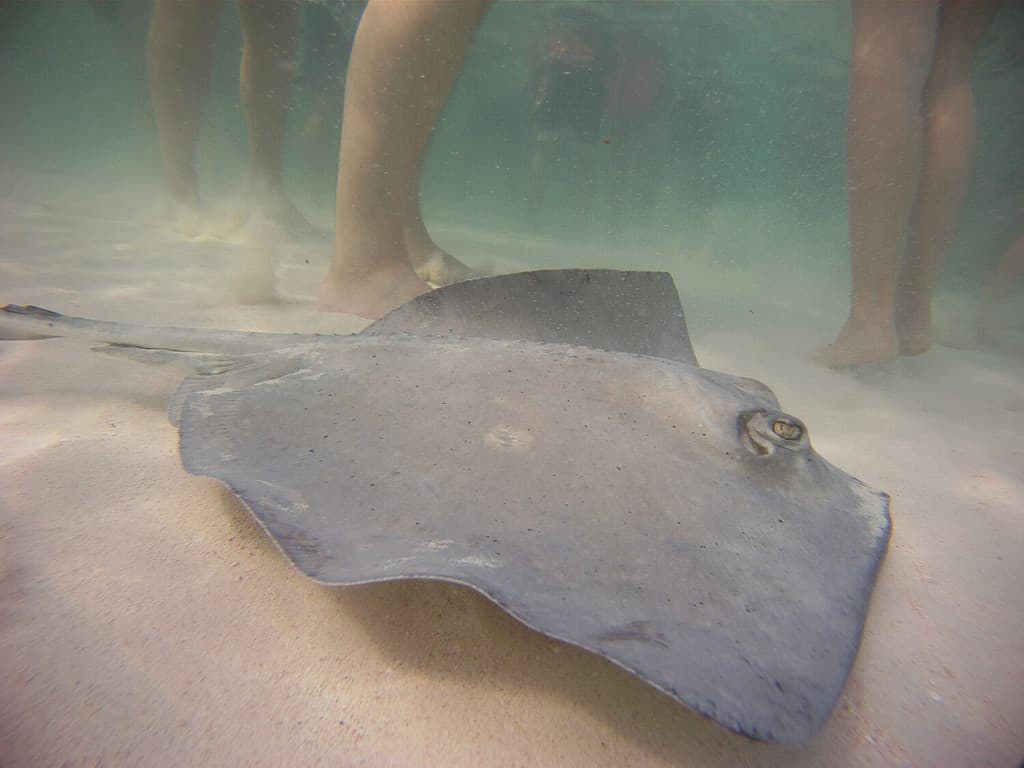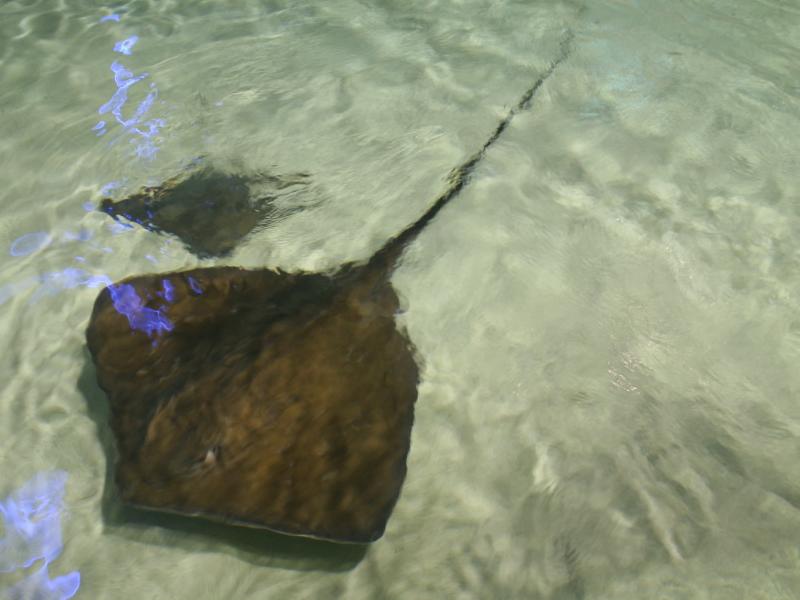Many people are aware of what stingrays look like, but there are also a lot of misconceptions about them. The name itself is off-putting, reminding us that these creatures do “sting” with a sharp venomous barb on their tails. Fear of stingrays was tragically validated in 2006 when the popular zookeeper and television personality Steve Irwin was fatally stabbed in the heart by a stingray barb while swimming in chest-deep waters of the coast of Australia. Yet on the other hand, aquariums often offer even small children the chance to pet and feed captive stingrays. And if you go on vacation to Grand Cayman Island, you’ll find that one of the most popular attractions there is feeding wild stingrays (up to 50 at a time!) while standing on a shallow sandbar in the ocean. So what’s the story with these enigmatic creatures? Are they deadly or safe, or a little of both? And wouldn’t you like to know why a group of stingrays is called . . . a “fever?”
Key Points
- Stingrays are easy to identify from their flat bodies and long tails with venomous spines. Their stings are very painful but very rarely fatal.
- They don’t have bones but are made of cartilage like sharks, and like your ears and nose.
- Stingrays spend a lot of time feeding on the seabed, but when they swim they undulate their bodies or flap their “wings” and appear to “fly.”
- They are actually pretty peaceful and avoid people unless provoked. Their mouths even look like they are smiling good-naturedly!
- The number one enemy of a stingray is the hammerhead shark, which uses its wide head to hold the stingray down on the ocean floor and bite it repeatedly.
- It is safe to handle stingrays in designated places where they have become accustomed to people, being careful to follow all instructions strictly.
- Stingrays might lash out at people who step on them while wading in the ocean or who they mistake for sharks chasing them.
- Soaking the wound in the hottest water the person can stand will help reduce pain and deactivate the venom.
- Watch for signs of an allergic reaction, which can be fatal, and get the person to a hospital immediately.

©Vicki L. Miller/Shutterstock.com
All About Stingrays
Description
Stingrays aren’t hard to identify, as there isn’t too much else like them in the ocean. They are large, flat, pancake-like marine animals with whip-like tails that have venomous barbs on them. Like sharks, and like your ears and nose, they don’t have bones but are made of flexible cartilage. Amazingly, there are actually 220 different species of stingrays that can range in size from the diameter of a dinner plate to the length of a canoe (16 feet). Sometimes you’ll hear the terms “stingray” and “manta ray” used interchangeably, but even though they look similar, they have some striking differences. Manta rays are related to stingrays but are tremendously larger, growing up to 23 feet long, have a wider “wingspan,” and do not have barbed tails.

©A-Z-Animals.com
Habitat
Stingrays live mainly in warm tropical waters along the coastlines of every continent except Antarctica. Some live in the deep ocean, though, as far north as Canada and as far South as South America, Africa, and Australia. There are also some freshwater species that live in rivers like the Amazon and Mekong, which, to be honest, are so large they could understandably be mistaken for seas. Some of the biggest stingray species in the world are the freshwater kind. For example, the giant freshwater stingray (Himantura chaophraya) of Southeast Asia can weigh up to 1,300 pounds.

©Mekong on tour/Shutterstock.com
Behavior
To swim, stingrays may bend their “wings” in a flapping motion, or undulate their whole bodies in a waving motion. This is a really effective way of moving through the water, so they can reach speeds of up to 30 mph, which, for comparison, is faster than most dogs can run. Rather than swimming around, though, stingrays love chilling on the ocean floor, buried lightly in the sand to help camouflage them from predators such as sharks while they feed on bottom-dwelling creatures like worms, clams, and shrimp. They locate their prey by using electrical sensors to detect their bioelectric fields. They have a strong set of teeth that are able to crunch through the shells of mollusks. Tiger sharks, hammerhead sharks, seals, sea lions, and large fish are their mortal enemies. A hammerhead shark uses its wide head as a tool to hold down the body of a stingray while biting it repeatedly until it dies. On its part, if attacked, a stingray will thrust its barbed tail upward to stab the shark and scare it off or kill it.

©frantisekhojdysz/Shutterstock.com
Why is a Group of Stingrays Called a “Fever?”
Stingrays are mostly solitary creatures but they do come together in large groups when they breed and migrate. Some of the largest species never stop swimming and migrate in enormous groups of up to 10,000 individuals. The term “fever” does not refer to temperature, but to the frenetic activity of such large groups of stingrays during mating and when competing for food in a concentrated area. So it’s used more in the sense of activity at a “fever pitch.”
Is it Safe to Handle or Swim With Stingrays?
If you are visiting an aquarium or a designated outdoor feeding area where stingrays regularly interact with people, then it is safe to handle them or swim with them as long as you follow directions. In some cases, the barbs have been removed so that there is no possibility of a guest getting stung, although you should take care not to put your fingers in its mouth. Stingrays might also put their mouths on your skin and suck on it, as they do to the ocean floor when looking for bits of food. It is harmless unless you allow the stingray to stay too long and leave a temporary mark. In other cases, you might go on an organized tour to feed and interact with wild stingrays that still have their barbs. As long as you are in an area where tourists regularly do this, the stingrays that gather there are used to being gently handled and fed and are unlikely to hurt you.
Any time you are in an area with stingrays, even if they are gentle and docile, it is best to walk forwards, not step backward, and walk with a shuffling motion that will warn any on the bottom to move so they don’t get stepped on. Handle stingrays gently and do not try to hold on to them. Let them pass gently through your hands without touching their barbs. They may gather around you to explore for food and you’ll feel them touching you, but just move around slowly in a calm and flowing way and you and they will have a nice rewarding experience.

©Drop Zone Drone/Shutterstock.com
What to Do if You Get Stung by a Stingray
When people do get stung by stingrays it is often because they step on them accidentally, try to handle them when they don’t want to be handled, or are mistaken by the stingray as a predator. Thousands of people are stung by them every year, just like jellyfish stings, but only about 20 people around the world are reported to have died from stings. There are two ways this can happen: because a barb hits a vital organ, or because the victim is allergic to the stingray’s toxin. In the case of the world-beloved Steve Irwin, the short-tail stingray that killed him likely mistook him for a shark and stabbed him hundreds of times as it thrashed around, including a fatal stab to the heart.
In most cases, however, the barb of a stingray causes a bleeding wound that can swell and turn red or blue. People who have been through this say the pain is excruciating and gets more and more intense for the first 90 minutes. The pain may be limited to the area of the wound or it may spread to a wider area. Usually, it diminishes in 6-48 hours but sometimes can last for weeks.

Immediate first aid for a stingray sting is to apply pressure to stop the bleeding and immerse the wound in the hottest water the person can stand without scalding them. This might be a temperature of about 113° F. This deactivates the venom and helps deaden the pain. After the pain diminishes somewhat, gently wash and bandage the wound. Infection is a possible complication of a stingray wound, so it is recommended to have it checked out by a medical professional even if you think it is not very serious.
The pain and surprise of being unexpectedly attacked can cause some victims to feel nauseous and have an elevated heart rate, but if these symptoms are severe or accompanied by muscle cramps, fainting, fever, or shortness of breath, it may be a sign of an allergic reaction. A severe reaction to stingray venom can lead to seizures, paralysis, and death. If you notice any of these symptoms, call 911 immediately and administer CPR if necessary and if you are trained to do so.
If you’ve read this far, it’s clear you are far more interested in stingrays than just what a group of them is called. Why not investigate online the nearest aquarium where you can see and even handle one yourself? Or maybe save up the big bucks and take that Caribbean vacation you’ve been dreaming of and see them in their natural habitat . . . safely shuffling along, of course.
The post What Is a Group of Stingrays Called? appeared first on AZ Animals.
from Animal News, Facts, Rankings, and More! - AZ Animals https://ift.tt/XhaAwPI